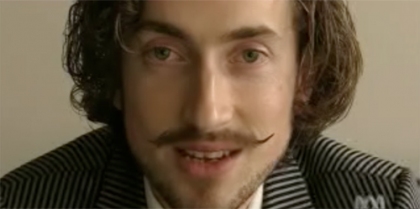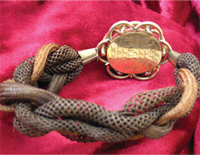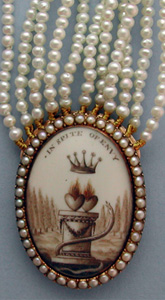Interview with Hayden Peters,
Mourning Jewelry Historian and Collector
Mourning jewelry represents a beautiful legacy - the art of remembering those who have gone before. In my attempts to understand the rich symbolism and language of mourning jewelry, I return time and time again to Hayden Peters' site, Art of Mourning (www.artofmourning.com). As a jewelry historian and collector, Hayden's expertise is extraordinary. Subscribe to his blog posts at www.artofmourning.wordpress.com, and you'll receive daily facts and features - I especially look forward to Symbolism Sundays.

(Some images courtesy of Barbara Robbins.)

How did you become interested in mourning art & jewelry?
I grew up with antique collectors/costume designers and had a great appreciation for history and 18th and 19th century costume design. I began to collect Victorian silver pieces when young (worked very hard for it all) and eventually found a mourning ring with 'In Memory Of' written on it from 1853. I thought the sentiment of love was the most beautiful thing that two people could share and to wear it on your person is simply beautiful. Tokens of love and affection that can be worn really speak to the innate nature we all share and there is nothing more pure and honest than to show it outwardly.
 How has mourning jewelry changed over time?
How has mourning jewelry changed over time?
Mourning jewelry has been around for as long as people have worn a token of love to memorialize someone, from prehistoric times to now, but the period of c.1680-1900 turned this into an enormous industry which mass-produced pieces to facilitate the social necessity of mourning fashion and presentation. Currently, it is more personal and each piece commissioned is truly the prerogative of the person who wears it.
What are some of your favorite pieces?
My favorite pieces are a Charles I memorial pendant, which was made by a royalist to show their loyalty to the crown in 1648 and a lovely 'coffin' ring from the early 18th century with a coffin shaped crystal on top that has a skull in enamel underneath. But I think the most special is the first ring I bought from 1853, which was dedicated to 'Mary Ann Lewis' who passed in 1853. I researched the ring and her family, then 15 years later, the sister piece to the ring made its way into my collection my chance. A dealer who doesn't bother with 19th century pieces contacted me out of the blue, as she knew I liked the sentiment and offered some pictures of the ring. Low and behold, it was for Mary Ann Lewis in 1853. I've never seen the design before or since.
 Why was public mourning so prevalent in the Victorian era?
Why was public mourning so prevalent in the Victorian era?
Due to high mortality rates and the establishment of the 'family' as a paradigm in the 19th century, mourning presentation became important to facilitate social projection in society. When Prince Albert died in 1861, Queen Victoria went into perpetual mourning and as the royal family was previously seen as the epitome of fashion in society, mourning became adapted into the mainstream fashion mentality. Jet jewelry worn at court to the propagation of integrating mourning into Western cultural dress meant that the period of 1861-c.1880 was the height of the industry. Also, the US Civil War helped to perpetuate this across the pond.
 What were popular types of Victorian mourning jewelry?
What were popular types of Victorian mourning jewelry?
Rings were quite common between men and women, even during the 19th century, where men's jewelry wasn't as predominantly worn as it had been during Regency and previous periods. The rise in photography gave the locket and pendant popularity since 1840 (as it still is today). Post 1854 with the Hallmarking Act for lower grade alloys used in jewelry, items became bigger and satisfied the demand for cheaper photography to be worn on the person. Bracelets had been popular throughout the 18th and 19th century, worn outside the dress, especially post 1850 with larger styles being used to accommodate larger dresses.
 How did hair jewelry come about?
How did hair jewelry come about?
Wearing hair is ancient in its intent, wearing the hair of a loved one or keeping something of them when they are away/passed on is typical through many cultures. As table-worked and professionally mounted in jewelry, the hair work industry started to emerge in the late 17th century. By the 18th century, women began to find professional work (outside the home) behind the scenes doing table-working for hair (the men still fronted the businesses) and by the 19th century, hairwork was a legitimate art in itself. During the 1850s, the French had a love affair with the material, with such artists as Limmoniér writing about its qualities. Mark Campbell's Self Instructor in the art of Hair Work Dressing Hair, Making Curls, Switches, Braids and Hair Jewelry of Every Description (1878) epitomized the styles and forms that had developed throughout the 19th century.
 What would a Victorian think of our contemporary attitudes toward mourning?
What would a Victorian think of our contemporary attitudes toward mourning?
As an historian, it is dangerous to apply modern thought to contemporary thought and vice-versa. That said, I would think that a late 19th century woman would consider our liberated stance towards the culture of mourning quite a positive thing, as there was a swing back towards the individual. People now can mourn in their own right, without the pomp and circumstance. The older generation of 1880 would possibly think that we were indecent.
 The most unusual mourning item you've encountered?
The most unusual mourning item you've encountered?
For a memento mori, which is more ecclesiastical in basis and not really 'mourning', I would say that the Sedlec Ossuary at Kutná Hora is quite a sight, but I do love the phenomenon of the miniature eye portrait (for both sentimental and mourning purposes), as they are anonymous and all individual.
Do you have any personal memento moris?
Philosophically, I live my life to the utmost, as I don't know how much time I have left and that is my most fundamental reason of being. In jewelry? Yes, I have several items with the presentation of skulls that transcend mourning from the 16th and 17th century from both the UK and France which were worn as personal statements of final judgment.







